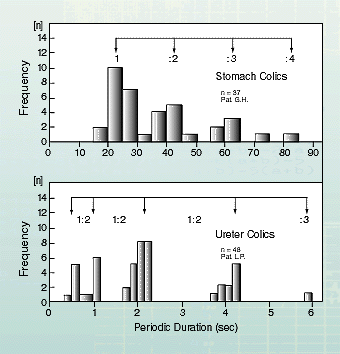| SUN UNIVERSITY |
| SCIENTIFICALLY INTRODUCING UNIVERSALITY TO THE UNIVERSITY |
Prof. Dr. med. Gunther Hildebrandt • Chronobiological Aspects of Music Physiology
We can become aware of the musical proportions through the series of individual waves of pain during a colic-like attack in the stomach area, as for instance with ureter cramps. Illustration 9 shows two examples of this, in which the time intervals of such events are presented as frequency distributions.
In the average area of the three-structured system of the autonomic rhythms, with the respiratory and circulatory rhythms, two diametrically opposed functional principles of the temporal organisation of life processes collide, and must be balanced (cf. illustration 7): a temporal structure which is constantly frequency modulated by the incoming information, and an other whose rhythms are bound to a pre-formed harmonic-musical order. This is then stabilised by being connected to the environmentally synchronised long wave rhythms.
The rhythmic functions of this average area unite both by showing a relatively wide range of variation of their frequency and answering demands on performance with frequency modulation on the one hand (e.g. quickening of the heart and breathing at work), and on the other hand, however, – particularly under peaceful conditions – search for preferential frequencies and/or frequency norms which have simple whole numbered connections and emphasise the fundamental harmonic temporal structure.
In the average area of the three-structured system of the autonomic rhythms, with the respiratory and circulatory rhythms, two diametrically opposed functional principles of the temporal organisation of life processes collide, and must be balanced (cf. illustration 7): a temporal structure which is constantly frequency modulated by the incoming information, and an other whose rhythms are bound to a pre-formed harmonic-musical order. This is then stabilised by being connected to the environmentally synchronised long wave rhythms.
The rhythmic functions of this average area unite both by showing a relatively wide range of variation of their frequency and answering demands on performance with frequency modulation on the one hand (e.g. quickening of the heart and breathing at work), and on the other hand, however, – particularly under peaceful conditions – search for preferential frequencies and/or frequency norms which have simple whole numbered connections and emphasise the fundamental harmonic temporal structure.

Illustration 9
Frequency distributions of periodic duration of pain waves in a patient with unclear stomach colics and a patient with ureter colics. The arrows accord to whole number harmonic proportions.
(According to HILDEBRANDT 1968)